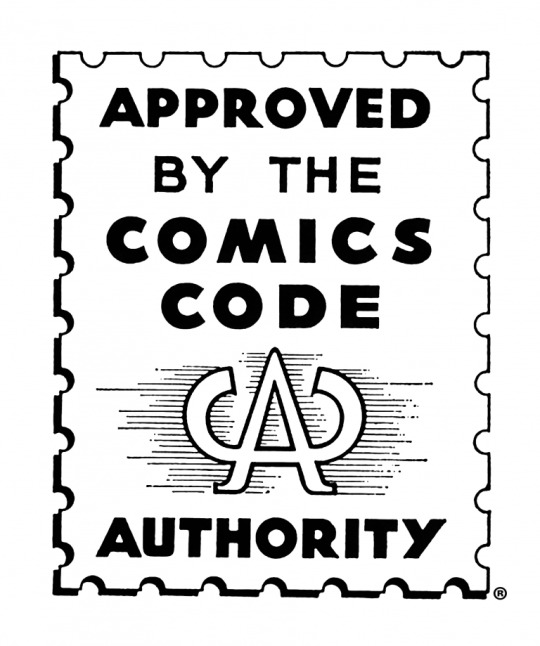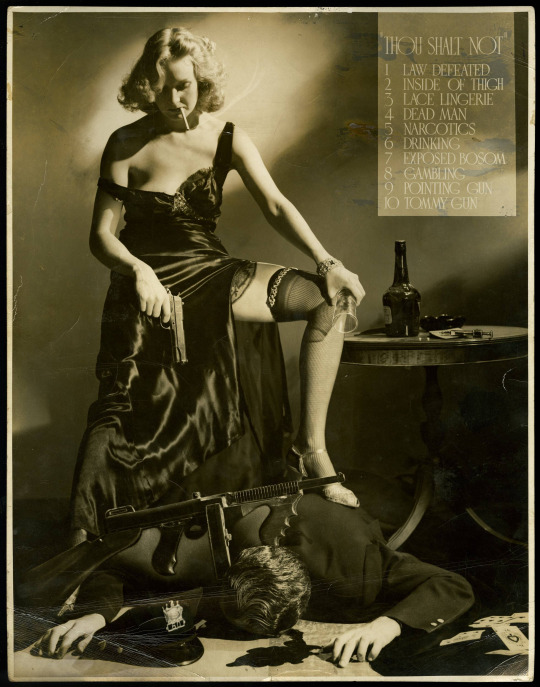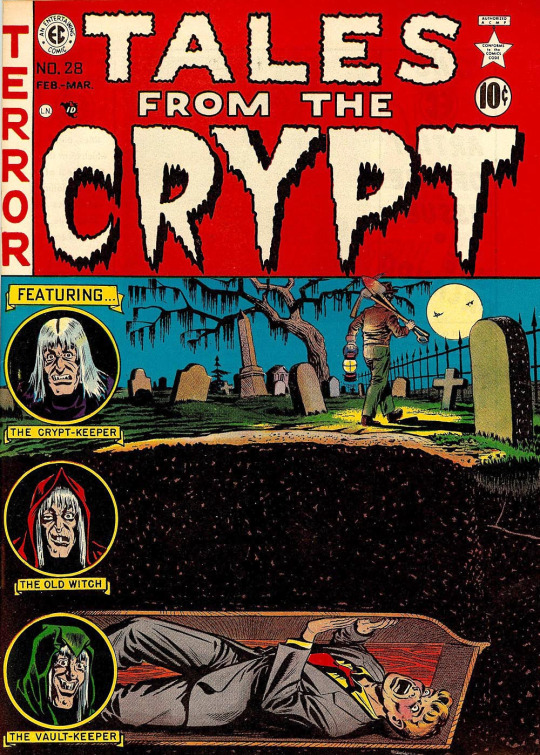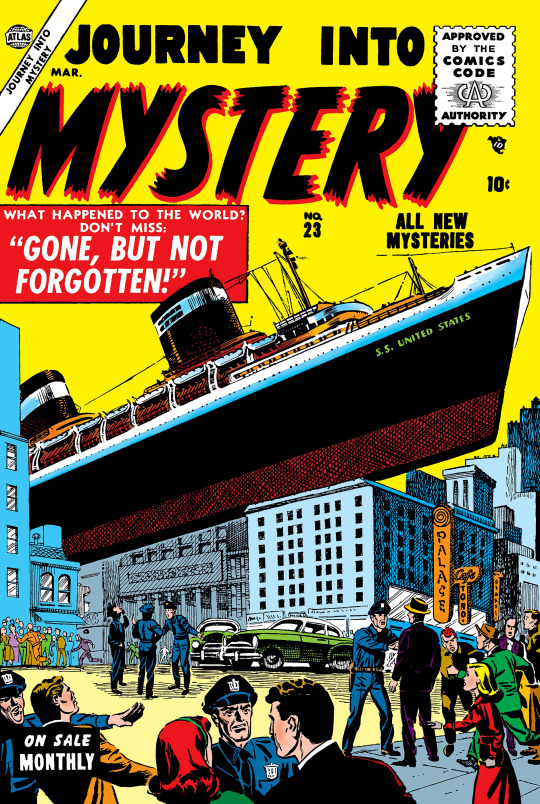#Comics Code Authority
Explore tagged Tumblr posts
Text
Dick Grayson remains one of the more important superheroes as the only Robin the general public gives a shit about, and given his mere existence was crucial in the formation of the Comics Code Authority.
257 notes
·
View notes
Text

I made this ages ago but realized I never shared it here. Let the world know you are DISapproved by that censorship board the Comics Code Authority, (may it rest in piss). I’ve got it on stickers and pins and hoodies and coasters and all sorts of things, and then there is also a smaller sticker two pack on my shop if you hit view other works
#comics#cca#the cca#comics code authority#the comics code authority#sticker#stickers#hoodie#shirts#t shirt#hats#marvel#dc#dc comics#marvel comics#vertigo#vertigo comics#image comics#wildstorm#wildstorm comics#the authority#cbldf#comic book legal defense fund#silver age comics#Batman#batfam#x men#jason todd#daredevil#redbubble
35 notes
·
View notes
Text
Villains in superhero comics be like
Tele-Horse (Philip Colt) first appeared in "Tales to Mildly Interest" #37. In his debut he teleported every horse in New York to his lair where he felt they would like it better.
While treated as a legit threat for awhile, writers eventually felt his gimmick was too silly. In "Unnecessary New Young Do Gooders West" #7634 Tele-Horse was defeated by a newborn baby.
Then in "Brand Spanking New Mister Integrity" #12, the writer remembered that Tele-Horse was originally a threat. No longer having to worry about the Comics Code Authority, Tele-Horse killed Mister Integrity (John Johnington) by teleporting 30 horses inside his lungs
#supervillain#super villians#supervillains#super villain#super villains#superhero#superheroes#superhero universe#superhero comics#superhero books#superhero media#comic#comics#comic books#comic villains#villainous#comics code authority#horse#horses#marvel#dc#marvel characters#dc characters#marvel and dc#DC and marvel#marvel comics#dc comics
22 notes
·
View notes
Note
Was the Comics Code as bad as the Hays Code?

That's a really good question!
I suppose it depends on what you mean by "as bad" - are we talking about the overall impact of the Code on American pop culture or are we talking about the actual content of the Code and what it banned and/or mandated in terms of artistic expression?
I've written a little bit about the Hays Code here, but my main focus was on subtextual judaism in Hollywood generally rather than what the Code was and what its impact on American cinema was.

So what did the Hays Code actually include?
One of the few positive things you can say about it is that the men who devised it were quite clear and forthright about what would and wouldn't be allowed, in comparison to the vagueness and inconsistency of the modern MPAA. So here's the list of what couldn't be shown:
Pointed profanity—by either title or lip—this includes the words God, Lord, Jesus, Christ (unless they be used reverently in connection with proper religious ceremonies), Hell, S.O.B., damn, Gawd, and every other profane and vulgar expression however it may be spelled; (You'll notice that the Code is very much a snapshot of the transition from silent movies to "talkies," with the discussion of how profanity is spelled as well as produced via "lip.")
Any licentious or suggestive nudity—in fact or in silhouette; and any lecherous or licentious notice thereof by other characters in the picture;
The illegal traffic in drugs;
Any inference of sex perversion; (i.e anything having to do with LGBT+ people and culture. For more on the impact of the Hays Code on the LGBT+ community, see the excellent documentary the Celluloid Closet.)
White slavery; (the 1920s version of sex trafficking, but with added racism!)
Miscegenation;
Sex hygiene and venereal diseases;
Scenes of actual childbirth—in fact or in silhouette;
Children's sex organs;
Ridicule of the clergy;
Willful offense to any nation, race or creed; and (this one was really honored in the breach more than the observance when it came to nations, races, and creeds of non-dominant groups in society.)
The following things could be shown, but "special care be exercised in the manner in which the following subjects are treated, to the end that vulgarity and suggestiveness may be eliminated and that good taste may be emphasized:"
The use of the Flag;
International Relations (avoid picturizing in an unfavorable light another country's religion, history, institutions, prominent people and citizenry); (again, depended a lot on what country you're talking about.)
Arson;
The use of firearms;
Theft, robbery, safe-cracking, and dynamiting of trains, mines, buildings, et cetera (having in mind the effect which a too-detailed description of these may have upon the moron); (I guess the idea was that the MPPDA believed very strongly in the idea that media could affect people's behavior through imitation, but the use of the word "moron" gives me eugenics vibes.)
Brutality and possible gruesomeness;
Technique of committing murder by whatever method;
Methods of smuggling;
Third-Degree methods; (i.e, torture)
Actual hangings or electrocutions as legal punishment for crime; Sympathy for criminals; (this was a big one; Hollywood had done very well from gangster films, so a lot of creators had to do some careful threading of the needle to keep the genre alive. One dodge that they came up with was that they would have a duplicate "final reel" in which the gangster would have their inevitable comeuppance, and then remove the final reel when the censors had left the theater. Very popular with white rural teens.) Attitude toward public characters and institutions; (again, Hollywood shifting from being anti- to pro-establishment.)
Sedition;
Apparent cruelty to children and animals;
Branding of people or animals;
The sale of women, or of a woman selling her virtue;
Rape or attempted rape;
First-night scenes; (i.e, wedding nights)
Man and woman in bed together; (hence the eventual TV practice of showing married couples in separate beds in the 50s)
Deliberate seduction of girls;
The institution of marriage;
Surgical operations;
The use of drugs;
Titles or scenes having to do with law enforcement or law-enforcing officers;
Excessive or lustful kissing, particularly when one character or the other is a "heavy".
So in general, we can say that the Hays Code was extremely sex-negative, very concerned about crime and anti-establishment thinking, sexist, racist, and homophobic, and in general afraid of offending anybody.
So what about the Comics Code Authority?
So this is what the Comics Code looked like in 1954:
Crimes shall never be presented in such a way as to create sympathy for the criminal, to promote distrust of the forces of law and justice, or to inspire others with a desire to imitate criminals. If crime is depicted it shall be as a sordid and unpleasant activity.
Policemen, judges, government officials, and respected institutions shall never be presented in such a way as to create disrespect for established authority.
Criminals shall not be presented so as to be rendered glamorous or to occupy a position which creates a desire for emulation. In every instance good shall triumph over evil and the criminal punished for his misdeeds.
Scenes of excessive violence shall be prohibited. Scenes of brutal torture, excessive and unnecessary knife and gunplay, physical agony, the gory and gruesome crime shall be eliminated.
No comic magazine shall use the words "horror" or "terror" in its title.
All scenes of horror, excessive bloodshed, gory or gruesome crimes, depravity, lust, sadism, masochism shall not be permitted.
All lurid, unsavory, gruesome illustrations shall be eliminated. Inclusion of stories dealing with evil shall be used or shall be published only where the intent is to illustrate a moral issue and in no case shall evil be presented alluringly, nor so as to injure the sensibilities of the reader.
Scenes dealing with, or instruments associated with walking dead, torture, vampires and vampirism, ghouls, cannibalism, and werewolfism are prohibited.
Profanity, obscenity, smut, vulgarity, or words or symbols which have acquired undesirable meanings are forbidden.
Nudity in any form is prohibited, as is indecent or undue exposure. Suggestive and salacious illustration or suggestive posture is unacceptable.
Females shall be drawn realistically without exaggeration of any physical qualities.
Illicit sex relations are neither to be hinted at nor portrayed. Rape scenes, as well as sexual abnormalities, are unacceptable.
Seduction and rape shall never be shown or suggested.
Sex perversion or any inference to same is strictly forbidden.
Nudity with meretricious purpose and salacious postures shall not be permitted in the advertising of any product; clothed figures shall never be presented in such a way as to be offensive or contrary to good taste or morals.[16]
You'll notice the similarities when it comes to the Codes' attitude to sex, sexuality, crime, and symbols of authority - so to answer the first part of your question, I would say the CCA was pretty similar to the Hays Code (in part because Charles F. Murphy, who drew it up, was deeply unoriginal and basically cribbed off the Hays Code throughout).
However, there are also some significant areas of difference that have a lot to do with the unique circumstances of the 1950s moral panic over comics. See, in the 1950s, superhero comics were considered deeply uncool and old hat - they had been huge in the 40s during the war, but by the 50s the biggest genre in comics were horror, crime, and romance comics (with cowboy comics bringing up the rear). To quote myself from another post:
"This gave rise to a moral panic in the 1950s, although more accurately it was part of the larger moral panic over juvenile delinquency. The U.S Senate established a Juvenile Delinquency Subcommittee of the Judiciary Committee in 1953 to investigate the causes of juvenile delinquency and comics became a major target. While Wertham’s book is best known today for its assertions that Batman and Robin were teaching young boys to be gay and Wonder Woman was teaching young girls to be lesbians, the main focus of the Subcommittee [edit mine: and Wertham's academic work] was on horror and crime comics for their depiction of sex, violence, and “subversive” attitudes to law and order."

The CCA made it impossible to publish two of the most popular genres in the industry for a generation (the CCA relaxed its stance on horror stuff a bit in the 70s, which is why Marvel trend-chased werewolves and vampires the moment they could get away with it), which not only scrambled the medium (and potentially created space for the Silver Age of superhero comics to flourish) but drove the former titan EC Comics practically out of business. (Indeed, William Gaines of EC Comics believed that the CCA had been specifically worded to drive him out of business.)
So in some ways, the CCA was worse.
#subtexual judaism#cultural history#film history#hays code#comics#comics meta#comics code authority#cinema
304 notes
·
View notes
Text
I hate-love silver age comics.
One one hand they can be fun and campy.
On the other they are soulless, nonsensical, and overly censored.
For those of you who don’t know- back in the time between the golden and silver age people started thinking that comics made kids into gangsters.
Literally the equivalent of saying that video games cause violence.
Right so- ✨the comics code authority✨ was created. If you had the stamp on your comic it was like a guarantee to the buyer that there was nothing that could remotely be a bad influence inside the comic.
bc of the public craze over comics ‘brainwashing’ the young- most of the big guns in comics just refused to publish comics without the stamp.
Funny enough- it died out after the government wanted marvel to publish a drug psa and the use of drugs was deemed inappropriate by the comics code authority.
…
Point is- fuck the comics code authority.
Also fuck you Collin.
#this is a really simplified explanation#i recommend researching yourself#it’s really interesting#batman#batfam#dc comics#dc robin#bruce wayne#silver age dc#silver age comics#marvel comics#comics code authority
33 notes
·
View notes
Text

Journey into Mystery #23, March 1955 (1st month of the Comics Code Authority approval stamp—look how big it was!). Cover pencils & inks by Carl Burgos, colors by Stan Goldberg.
Info from @grandcomicsdatabase
#journey into mystery#journey into mystery 23#1950s#comics code authority#cca#carl burgos#stan goldberg#marvel#marvel comics#atlas comics#s.s. united states#ocean liner#ocean liners#ships#emergency#comic covers#comics#comic books#cover art#golden age comics#sci fi#scifi#science fiction#gone but not forgotten
23 notes
·
View notes
Text
There's a bit of a moral panic going on about comics on old people YouTube - that is, the idea that the youth crave a return to the Hays Code and, more relevant, the Comics Code Authority era of writing.
Girl, no they don't. Come on. Those of us who are now in our 30s and 40s just spent a whole youth as the subjects of so many moral panics about our media consumption and should be able to see through this. This idea is just another one of those and it's a really silly one at that.
The majority of The Kids even outside of fandom spaces are watching shows with all of these really complex characters from super diverse backgrounds. A handful of weirdo incel boys and white twenty-somethings who think they're "traditional wives" because they have a backyard hobby farm are not "the zoomers," they're just the same vocal minority of weirds we knew as Young Republicans and Home School Kids.
In comics specifically, it really does seem, even outside of fandom, that the young audience is made up of more women than ever, which reflects the fact that young women simply read more than young men. Characters like Miles Morales are now absolutely beloved when their inclusion was controversial back in our day 👴. The criticism of the X-Men is no longer that it's just "SJW rants" but that their rants aren't SJW enough and that the book's cast should be more diverse. Young people have wholeheartedly embraced queering characters like Tim and Kon.
It's just such a weird made up "videogames make kids violent" style moral panic among men my age and it's toasting my buns bro.
15 notes
·
View notes
Text
Instead of saying "I want to kill myself" I now say "I'm going to violate the Hays Code." "I'm going to violate YouTube terms of service." Or "I'm going to violate the comics code." And I hate realizing all three of those mean the same thing. Progress is moving backwards in this society.
#anti censorship#anti capitalist#anti capitalism#196#my thougts#free speech#leftist#left#leftism#youtube#hays code#comics code authority
179 notes
·
View notes
Text
OLLIE'S FORGOTTEN TRANS FRIEND
Ollie was friends with a trans woman in high school.
In the story Clash Reunion('Tec #446-448) Ollie is trying to find old classesmates who are possible targets of assassination attempt. One of them is Billie Jean, Ollie knew her as William.
He didn't even know she was that close to him.

When he finally finds her, she walks away never to be seen again.


This is was released in 1985, and would have been an easy target of the CCA from the time. Only in 1989 the rules that were used to keep queer characters out of comics were removed.
I wanted to see more of this plot with Billie Jean.
#transgender#Ollie#Dinah#Green Arrow#DC#Oliver Queen#CCA#Comics Code Authority#Joey Cavalieri#trans representation#Billie Jean#Detective Comics#backup stories#1985#1980s#The more I read this run the more I like it#I'm not reading in order tho#Already read the last story. Just missing 4 issues post-night olympics
25 notes
·
View notes
Text




Lois Lane in The Bakery Counterfeiters from Superman #29 (1944) by Don C. Cameron & Ed Dobrotka
Sometimes we're more told than shown why Lois Lane is such a well-regarded investigative journalist. This 4 page story from the 1940s is a great example of how she began building that reputation a long time ago. While covering a simple puff piece assignment for the Daily Star she uncovers a racket scheme that was using a bakery as a front to operate. The woman could not go out to buy bread without revealing some criminal plot
In these golden age stories Lois had solo adventures without or with minimal help from Superman, they can be found in issues #28 to #40 and #42 from the first Superman series. Lois is already in love with Superman and she appreciates his help in her investigations, but she's way less desperate and shallow than she would become in the 1960s due to the CCA (Comics Code Authority)
Reading Lois Lane stories is always a delight, from her more realistic, independent and snarky portrayal in the 40s and 50s to the completely unhinged scheming person she becomes later, nevertheless, she's always sharp and obstinate no matter the time period. It's always fascinating and fun to follow her adventures and you can really see how women representation in the mainstream American media changed throughout the years by reading her stories
#her whole attitude in this... priceless#lois lane#superman#golden age comics#golden age superman#favorites#comic book history#text#dc comics#dc#comics code authority#comics#reading log#vintage comics#comic recommendations
23 notes
·
View notes
Text

Vintage Comic - Facts About Code-Approved Comics Magazines
Comics Magazine Association (1958)
#Comics#CCA#Comics Code Authority#Comics Magazine Association#Facts About Code-Approved Comics Magazines#Vintage#Censorship#Frederick Worthheim#Promotional Comics#Art#CGC#1958#1950s#50s#Seduction Of The Innocent#SOTI
17 notes
·
View notes
Text
My brain is a mess atm so I'm gonna try to keep this as cohesive as possible but god. I saw Across the Spiderverse for the second time yesterday night and I had completely forgotten the opening with the Comics Code Authority seal. My first time watching me and my friends laughed at that scene, "Haha lmao they're spoofing on the comics code authority a bit, hell yeah" I had thought, and I moved on to the masterpiece that was ATSP. The second time though, after knowing all the themes and ideas of the movie, the comics code seal hit me like a truck. Because Miles's story could NEVER be approved by the comics code. Neither could Pavitr's, nor Gwen's and definitely not Hobie's for that matter. And this ties back exactly to the themes of the movie because Miles's story is about rejecting conventional storytelling and the norms of what a Spiderman story should be. In the same way that Miguel is so obsessed with maintaining canon, maintaining the status quo of the Spiderman mythos, the entire point of the comics code was to restrict stories with new perspectives that didn't fit a certain agenda. It was when comics were able to break free from the code that we got so much innovation and diversity and complexity. And I know that morally Miguel and the Comics Code are definitely not a 1 to 1 comparison but in a meta sense, viewing ATSV's themes as a commentary on storytelling conventions, it fits perfectly I think.
#i fuckingn. love this movie#any piece of fiction that poses a meta commentary on storytelling norms and breaks through those norms is a masterpiece in my book#i think this is part of why i enjoyed atsv more than itsv#i just have a soft spot for it#across the spiderverse#spiderman across the spiderverse#spiderverse#comics code authority#miles morales#spiderman into the spiderverse#textpost#teatime ramblings
123 notes
·
View notes
Text
the spider-woman comic was really interesting bc it came at a time when the comics code authority had loosened up a lot but still existed and still was a thing that mattered. so spider-woman could encounter a guy who looks normal but then lures women in and melts into a pile of living flesh and suffocates them, but there there had to be a page where they explained his backstory and that he got that way from a lab accident because the comics code forbade supernatural monsters
4 notes
·
View notes
Text
JUDGEMENT DAY (EC COMICS)
@thealmightyemprex @themousefromfantasyland @the-blue-fairie







JUDGEMENT DAY by Al Feldstein and Joe Orlando was originally published in EC comics "Weird Fantasy #18" for April, 1953.
The following comments page is from WF#20.

Before shifting focus to "Mad" magazine, William Gaines (then head of EC) intended to reprint JUDGEMENT DAY in EC's final Comic: "Incredible Science Fiction #33" for February, 1956.
The Comics Code Authority's (founded 1954) Judge Charles Murphy (acting outside the CCA's rules) tried to step in and whitewash the last panel.
A heated telephone shouting match ensued with Gaines and Feldstein firing off at Judge Murphey's overreach.
It ended when Murphy hung up on them; though, not before trying to 'compromise' once the threat of a lawsuit cropped up, "All right. Just take off the beads of sweat."
Gaines and Feldstein simultaneously answered, "Fuck You!"
JUDGEMENT DAY was printed in ISF#33, uncensored.
2 notes
·
View notes
Note
GRRM says Stan Lee made Comics a "respectable medium", do you agree? I always thought Lee, his involvement in CCA, and Marvel's focus on capeshit under him ultimately held back the medium.
I think it's indisputable that Stan Lee profoundly changed how comics were viewed in American culture (keep in mind, comics used to be seen as only slightly more scandalous than porn); even a more warts-and-all portrait like Riesman's True Believer points out that Stan Lee was a hugely successful promoter, salesman, and public personality. The whole "Merry Marvel Bullpen"/"Marvel Marching Society"/"No-Prize" stuff, the letters columns, the tv shows and cartoons, all of it made Stan Lee kind of the Walt Disney of comic books and made comics seem like a more wholesome pasttime for American adolescents.
Later on, Stan Lee's campus lectures (even though they were ultimately rather facile in their analysis) and his (wildly self-aggrandizing and mendacious) interviews with alternative news organizations like the Village Voice played a big role in making Marvel a significant element of the counter-culture and making comics "cool" for teenagers and college students to read.

Regarding Stan Lee's involvement with the CCA, are you referring to him breaking with the CCA over the Spider-Man issue or something else?
As for the focus on superhero comics, I think that was both incredibly successful and a necessary adaptation, given how the moral panic panic around comics in the 50s centered around horror and crime comics. Keep in mind, there really wasn't a market for what we call indie comics today until the counter-culture emerged in the late 60s/early 70s (and even then, we didn't really see indie comics comics until really the 80s with the British Invasion).
#comics#comics meta#marvel#marvel meta#stan lee#comics code authority#josephine riesman#true believer
58 notes
·
View notes
Text

dw he's not a real cop and this didnt really happen
#comics code#comics code authority#art#comic#school art#pen#traditional art#art?#sure#doodle#sketch#sketchbook#comics#gay#crime
9 notes
·
View notes